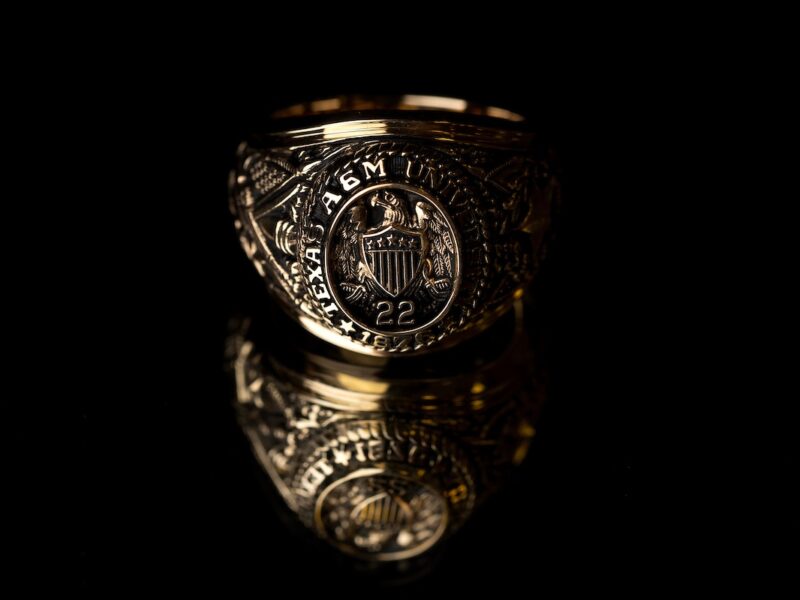Retiring UPD Police Chief Reflects On 40 Years Serving Aggieland
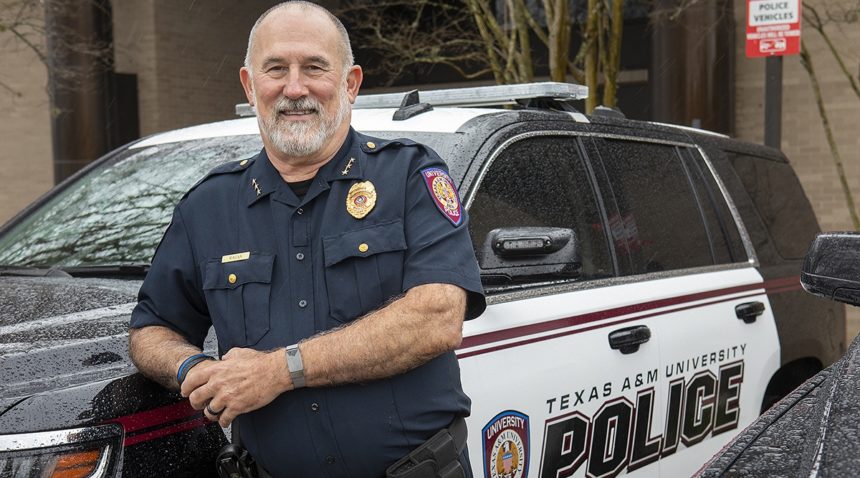
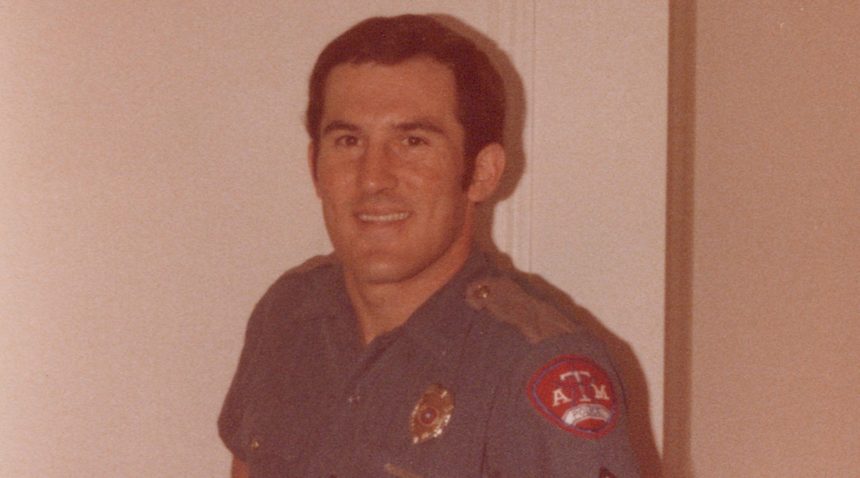
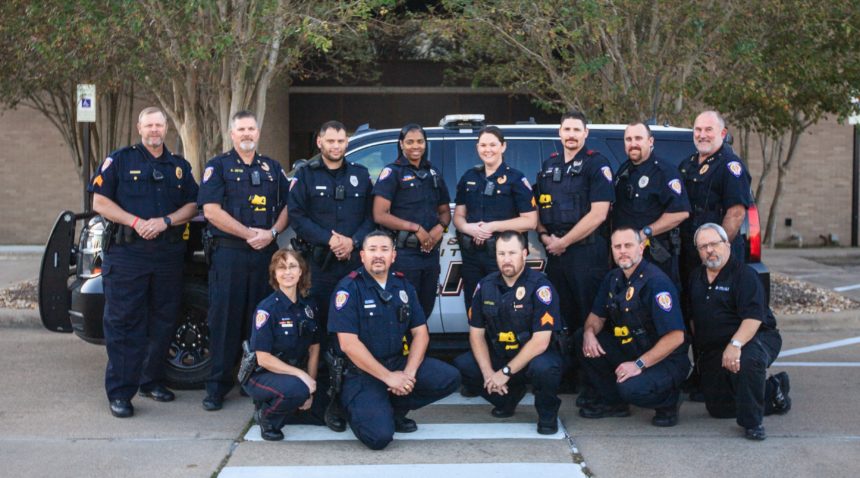
When Michael Ragan ’82 began as a police officer at the Texas A&M University Police Department (UPD) in 1980, the campus stood at around 1,700 acres and student enrollment was 36,127. Almost 40 years later, as he nears retirement as UPD chief, overseeing a 5,200-acre campus with almost 70,000 students, much has changed. But Ragan said the things that make Texas A&M so special – its people and its values – remain the same.
“While I think the generations are different – there’s different ideas and viewpoints – I think the core of what A&M is and has been, is still there,” he said. “I’m proud to be an Aggie and it has been a great honor to serve my university.”
Born in Richmond, Texas and raised in Houston, Ragan came to Texas A&M in 1978 to pursue to bachelor’s degree in economics.
His long career in law enforcement would likely come as a surprise to a teenaged Ragan. Coming out of high school, becoming a dentist was the goal. “But it didn’t take me too long to realize my strengths didn’t lie in the sciences,” he said.
He said his interest in law enforcement was born out of respect for the Houston police officers he came to know through family members, as well as the influence of his best friend, Mike Parinello, who had become a Harris County Sherriff’s deputy. Before Ragan came to A&M, Parinello encouraged him to become a reserve Sheriff’s deputy for Harris County, just to see if he liked it. Of course he did, so shortly after he came to A&M as a student, Ragan sought work with UPD.
After graduation, he rose through the UPD ranks from patrol officer, to sergeant, then captain. In 1984 he was promoted to assistant police chief and finally to chief in 2013.
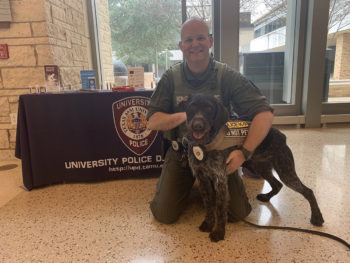
“Police Chief Mike Ragan has been an outstanding leader for the University Police Department,” said Chris Meyer ’80, associate vice president for safety and security. “I’ve known Mike for many years and we have worked closely together as colleagues since 2005. His fingerprints can be observed on virtually every aspect of UPD.”
That includes accreditation, which UPD earned in 2014 from the Commission on Accreditation for Law Enforcement Agencies (CALEA), a distinction earned by only 5 percent of law enforcement agencies, including university, city, county and state departments. Requiring annual audits and an on-site audit every four years, accreditation requires high professional standards in areas including community relationship-building, preparedness for natural and man-made critical incidents, independent review by subject matter experts, and more. The chief and his team carried the accreditation process over the finish line.
Under Ragan’s supervision, UPD added 26 staff members, including 12 police officers, some of whom handle dogs that are trained to sniff out explosives; began additional trainings in partnership with city and county law enforcement agencies; started community outreach programs including Coffee with a Cop and residence hall floor talks; and opened the UPD Twitter account which became one of the most followed university police accounts in the nation with nearly 40,000 followers. The department operates on a $7.9 million annual budget.
Ragan has earned a number of honors including Outstanding Crime Prevention Manager for four consecutive years (2013-16) by the Texas Crime Prevention Association, and the 2018 Bill G. Daniels Outstanding Administrator Award from the Texas Association of College and University Police Administrators.
UPD Lieutenant Bobby Richardson ’95 ’02 said the chief earned the crime prevention awards for finding new ways interact with the community, including social media and outreach programs, as well as for starting a “bait bike” program that dramatically reduced bike thefts.
During the course of his career, Ragan served under 12 university presidents, including the current 25th, President Michael K. Young.
“Texas A&M has been very fortunate that Chief Ragan has dedicated his time, talent and energy to our entire university community,” Young said. “Over more than four decades, it’s clear that his career became a calling. All of us owe him a deep debt of gratitude for serving our university with such great honor and distinction for so many years.”
Great Mentors
Ragan said he owes much of his career success and longevity to his UPD supervisors.
Col. Thomas Parsons ’49, namesake of the Parsons Mounted Calvary was his first boss, heading the department from 1978-83. “He was a wonderful man and a great leader,” Ragan said. “Even me, as a brand new guy, he took the time to talk to me, share this thoughts and ideas with me.”
Following Parsons as chief was Robert “Bob” Wiatt, who led the UPD from 1984-2004. “He had a long and successful career,” Regan recalled. “I was one of Bob’s first promotions; he promoted me to captain.”
It was Elmer Schneider ’71, chief from 2004-13, who moved Ragan on to chief when he retired. “He’s an Aggie, loves A&M, has a heart of gold. He taught me to always give credit where credit is due,” Ragan said. “He taught me a lot, they all did.”
Travelling With The Team
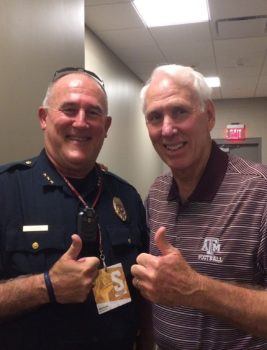
One job that Ragan said he was especially fond of was providing security at home and away football games. He travelled with the team for 34 years, throughout the reigns of head coaches Jackie Sherrill, R.C. Slocum, Dennis Franchione, Mike Sherman and Kevin Sumlin. “All the way up to Coach (Jimbo) Fisher,” he said.
He has especially fond memories of the 13 years spent with then-coach Slocum, who became the winningest coach in Southwest Conference history.
“No disrespect to any of the other football coaches, but I think the world of Slocum,” Ragan said. “He’s a class act.”
Slocum said he greatly enjoyed working with Ragan and that he was an integral part of the team.
“Our players trusted him and knew he had their best interest at heart,” Slocum said. “I wish him the best in his well-deserved retirement.”
Meyer said he remembers one particular football game from the 2018 football season in which Ragan was seemingly a lucky charm for the team. “The football team may really miss Chief Ragan,” Meyer said, recalling the Aggies’ overtime win over LSU two seasons ago. “We noticed that when the chief stepped out of Kyle Field Command into the hallway to take a telephone call, the Aggies scored. Like any true Aggie fan would, he agreed to stay in the hallway when we needed help on the field. I only hope the football team can succeed without his positive mojo.”
A Day He’ll Never Forget
Ragan was the assistant chief of police when Texas A&M experienced its worst disaster: the collapse of Bonfire on Nov. 19, 1999, an accident that killed 12 Aggies. “I’ll tear up,” he warned.
“I’d been working at the office late that night preparing the Bonfire plan [police staffing for the Bonfire burn],” he said, recalling that no sooner had his head hit the pillow in the early hours of Nov. 18, 1999 that the call came from dispatch that the stack had fallen.
“They said, ‘there are deceased, there may be as many as 12.’ And I thought about the 12th man, I still remember that,” Ragan said. “I remember the amazing work of the first responders, and the outpouring of love and support from the students, the community. Even UT honored us.
“My heart still breaks for the students and their families. They were Aggies that loved A&M, loved the tradition – their lives were just cut short. I’ve had other situations where I had to deliver death messages and things like that, but the magnitude of Bonfire, there’s never been anything like it and I’ll never forget it.”
Lucky To Be At A&M
Ragan’s love of his fellow Aggies is apparent. He said he already knew how fortunate he was to be leading UPD at Texas A&M, but that was reinforced each time he met UPD officers and administrators from other universities.
“I’d always ask people what policing is like at their universities and what I found is that I was really lucky to be at Texas A&M,” he said. “I won’t name any names, but a lot of them would say their students were really a handful for law enforcement. The student body as a whole at Texas A&M is very respectful of police.”
One Big Fire
Ask for a funny thing that happened to Ragan as a UPD patrol officer and he’ll swear off telling a certain, somewhat embarrassing story, but then does anyway.
He blushed as he recalled being on patrol early one evening in 1980. “Things were a little slower at A&M back in those days,” he said. He’d parked his car just up from the Mohair Lab, no longer on campus, but back then was by the tracks on West Campus. He rolled his window down and sat back to enjoy a sack lunch.
Then he heard a call from dispatch to another unit, reporting a fire alarm…at the Mohair Lab. “So I re-adjust my rear view mirror because the Mohair building is right behind me, and it’s engulfed in flames! I get on there and say ‘send the fire department, it’s burning!’
“I can’t imagine what anyone who was driving by was thinking,” he laughed. “There’s a giant fire and a UPD officer is just sitting in the shade, with the window down, eating his sack lunch.”
Fortunately, no one was injured. “That was one of those just shake your head moments,” the chief said.
Hopes For The Future Of Policing
Communication is key in good policing, Ragan said, when reflecting on this year’s killing of George Floyd by a Minneapolis police officer.
“A lot of good dialogue between law enforcement and the public opened up after this incident, just like it did after Ferguson,” he said, adding he was recently invited to a forum along with other area police officials to take questions from local community members.
“It seems these dialogues only happen when something bad happens, and then it stops until something bad happens again,” he said. “What I’m hopeful for is those lines of communication stay open. We want to hear their concerns, talk to them and remind them that you can’t just take all of law enforcement as a whole and say we’re all the same. We’re all individuals. Police in Bryan-College Station are different than police in say, New York City.
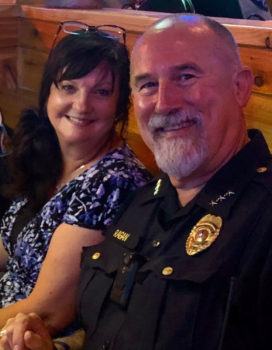
“There does need to be change on the law enforcement side. But I don’t want a year from now be back to where we’re not talking about the issues, we’re not having a dialogue.”
Staying Involved
Ragan said post-retirement that he and his wife, Pamela Ragan ’84, plan to travel and spend time with their grandchildren – one grandson, and one on the way.
“And I’m sure there’ll be plenty of ‘honey-dos’ around the house,” he laughed.
The Ragans met nearly 38 years ago when Pamela came to UPD as a student worker. They didn’t become a couple until 2018, and together brought two sons each, from previous marriages, all of whom have graduated from Texas A&M.
Ragan said he’s hoping to stay involved in law enforcement, having applied to be an assessor for CALEA.
He will miss interacting with students, faculty and staff on campus, he said, and that the list of people he connected to and admired during his career is simply too long. “I wouldn’t want to leave anyone out,” he said.
“Suffice it to say, I’ve been very lucky to work with so many great people over the years. I remember when the children of people I worked with started working or going to school here. Now it’s the grandchildren of those people!”
Media contact: Lesley Henton, lshenton@tamu.edu
